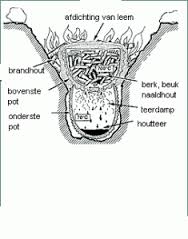Pitch is a collective name for viscous liquids such as tar and bitumen, which at room temperature look like a solid. By boiling down one can make tar from pitch.
 Since old times in our region is being fired from birch bark: tar oil, tar and pitch.
Since old times in our region is being fired from birch bark: tar oil, tar and pitch.
These products are used as adhesives, birch tar oil as a remedy e.g. against flakes in shampoo and ointment, hoof care, as impregnant, e.g. for making leather soles waterproof.
At the University of Bradford are chew marks and teeth marks on old tar and pitch crumbles researched. That may have been mixed with herbs to use like (medicinal?) gum.
The University of Copenhagen investigated 5,700 year-old chewable tar from a birch. This chewing gum contained DNA a young woman from the new Stone Age, with probably dark skin, brown hair and blue eyes. She came from Syltholm on Lolland, a Danish island in the Baltic Sea. She had recently eaten a meal with hazelnuts and wild duck. And without dairy: she was lactose intolerant. (Neanderthals were too, and many adults become it.)
Birch tar may have been chewed to make it warm and malleable enough to make tools (fix), to relieve toothache or other ailments, as a tooth cleaner, to suppress hunger, or simply as chewing gum.
Birch pitch is older than the Homo Sapiens. Neanderthals lived during the ice age, where the North Sea is now. The Batsjo Kirocave in central Bulgaria (explored since 1970) was an early stopping point 46,000 years ago for the first modern humans to travel from Africa and Southwest Asia to Europe. Homo sapiens gradually supplanted Neanderthals between 50,000 and 39,000 years ago.
On the beach of the Zandmotor near The Hague, a flint tool was dredged with a tar-like substance. The complex to produce birch pitch is 50,000 years old! In Campitello (Italy) there were even 200,000-year-old pitch remains!

Making birch pitch is a dry distillation of birch bark. This means that the bark is to be heated oxygen-depleted to a temperature of between 340 and (probably 370 to) 420 degrees. Moreover the pitch chars and below 340 degrees happens no conversion. When oxygen has access the bark will burn.
Todt Haupt investigated winning tiny bits birch pitch in a pit in the ground by stacking hot stones interspersed with layers of birch bark. By wrapping the package birch bark in green leaves there was no pitch dripping lost. On the rocks or in the pit were afterwards no traces of pitch found.
The Swiss Kuno Moser made a small amount of pitch by laying birch branches under a bed of glowing coals. The pitch could then be scratched of the timber.
Put on large, flat stones in a pit a layer of shredded birch bark of three cm thick, covered with a large piece of bark (protection from sand and dirt) and a layer of sand of 3 cm (against heat, combustion and oxygen supply). Heating them a good hour with a hot fire. The pitch is deposited on the stone.
In a single almost closed pot or small clay oven, it is also possible. First escapes the evaporating water as white steam from the bark. Subsequently, the smoke becomes yellow with a characteristic birch pitch smell. After fifteen minutes at the right temperature the bark is then converted.
The double pot method for the extraction of tar is the most efficient.
Birch oil flowing safely in the cool lower pot can be boiled down to birch pitch.
(From birch twigs they made brooms, wine of the juice, papery sheets of bark to write, bark rolls as candles, cups of bark... A versatile tree so.)
